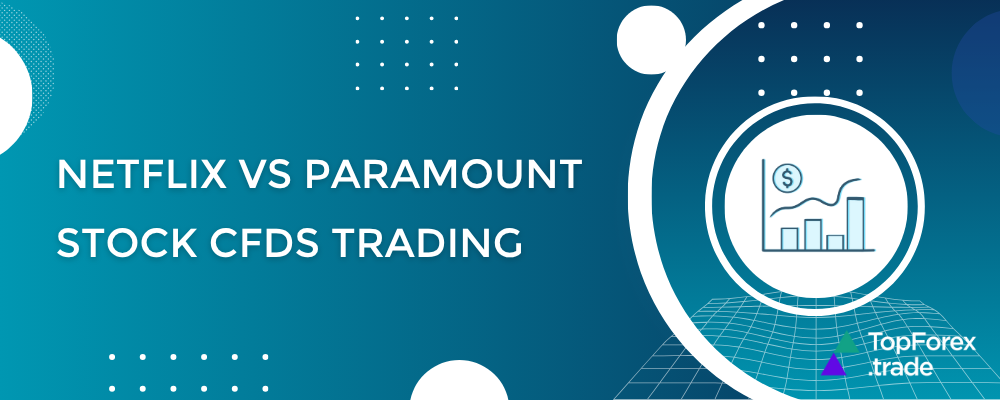Netflix vs. Paramount: 5 CFD trading strategies for 2025

The battle for dominance in the streaming industry continues to intensify, with Netflix (NFLX) and Paramount Global (PARA) emerging as key players in 2025. For CFD traders, this rivalry presents unique opportunities to capitalize on market volatility, earnings reports, and shifting consumer trends.
As the streaming wars rage on, which stock offers the better trade? Let’s break it down.
Netflix: the undisputed leader facing new challenges

Netflix remains the king of streaming, with over 300 million global subscribers as of mid-2025. However, its growth has slowed in mature markets, forcing the company to:
- Expand into live sports and gaming to retain users.
- Crack down on password sharing – boosting revenue but risking churn.
- Increase subscription prices, testing consumer loyalty.
Why trade NFLX CFDs?
- High liquidity – ideal for short-term trades.
- Earnings volatility – big swings post-quarterly reports.
- Tech-driven sentiment – AI recommendations and ad-tier growth influence stock moves.
Paramount: the underdog with a comeback strategy

Paramount Global (owner of Paramount+ and Showtime) has been fighting an uphill battle but is making aggressive moves:
- Merger talks (potential acquisition by a tech giant like Apple or Amazon).
- Exclusive sports deals (NFL, UEFA Champions League).
- Cost-cutting measures to improve profitability.
Why trade PARA CFDs?
- Speculative upside – takeover rumors create spikes.
- Niche audience strength – sports and news keep subscribers engaged.
- Cheaper valuation – compared to Netflix, PARA could see a bigger % move on positive news.
Key factors impacting both stocks in July 2025

- Q2 earnings reports – Will Netflix’s ad-tier growth offset slowing subscriptions? Can Paramount show profitability?
- Fed rate decisions – High rates hurt growth stocks like NFLX, but PARA’s debt could also be a concern.
- Streaming bundles – Partnerships (e.g., Paramount+ with Walmart+) could shift market share.
- Macroeconomic conditions – Recession fears may push consumers toward cheaper streaming options.
Trading strategies for trading Netflix and Paramount stocks

1. Earnings play – trading post-report volatility
Strategy: Buy or sell CFDs ahead of earnings, anticipating a big move.
Example: Netflix Q2 2025 Earnings
- Expectation: Analysts predict +8% subscriber growth due to ad-tier expansion.
- Trade: Buy NFLX CFDs before earnings, expecting a beat.
- Outcome:
- If NFLX reports +10% growth, the stock surges 7%, and profit from the rise.
- If growth is only +5%, NFLX drops -10% – short sellers win.
Risk management:
- Use stop-loss orders (e.g., -5% from entry).
- Hedge by trading PARA in the opposite direction (if NFLX falls, PARA may rise).
2. Merger arbitrage – betting on takeover rumors
Strategy: Buy PARA CFDs when acquisition rumors surface.
Example: Apple-Paramount merger speculation (July 2025)
- Rumor: Apple considers buying Paramount+ for $30B.
- Trade: Buy PARA CFDs at $18, expecting a jump to $25+.
- Outcome:
- If the deal happens, PARA spikes 30%+.
- If talks collapse, PARA drops back to $15 – exit with a stop-loss.
Risk management:
- Only risk 1-2% of capital per trade.
- Watch for SEC filings & insider leaks.
Learn more ➡ Forex risk management tools: automatic trading with popular market orders
3. Pairs trading – NFLX vs. PARA
Strategy: Go long on one stock, short the other, betting on relative performance.
Example: Netflix Price hike vs. Paramount’s sports deal
-
Scenario:
- NFLX raises prices → bearish sentiment.
- PARA secures exclusive UFC rights → bullish momentum.
-
Trade:
- Short NFLX at $600 (expecting a drop).
- Long PARA at $20 (expecting a rally).
-
Outcome:
- If NFLX falls -5% and PARA rises +10%, you profit from both sides.
Risk management:
-
Monitor correlation shifts (if both fall due to a market crash, adjust positions).
4. Trend following – riding breakouts
Strategy: Trade with the momentum using technical analysis.
Example: Paramount breaks key resistance (July 2025)
- Chart setup: PARA consolidates at $22, then breaks $25 resistance.
- Trade: Buy CFDs on breakout, targeting $30.
- Outcome:
- If momentum holds, PARA climbs +20%.
- If false breakout, PARA drops—exit below $24.
Risk management:
-
Use a trailing stop-loss to lock in profits.
5. News-based scalping – quick trades on headlines
Check out ➡ Scalping case study: strategies and FX brokers
Strategy: Exploit short-term spikes from breaking news.
Example: Netflix loses key show to Paramount+
- News: “Stranger Things moves to Paramount+ in 2026.”
- Trade:
- Short NFLX immediately on the announcement.
- Cover position after -3% drop.
-
Outcome: Quick $300 profit per lot in minutes.
Risk management:
- Set tight stop-loss (1-2%).
- Avoid holding overnight.
Key takeaways:
✅ Earnings = volatility → Trade pre/post-report.
✅ Mergers = spikes → Buy rumors, sell news.
✅ Pairs trading → Hedge long and short positions.
✅ Trend following → Ride breakouts with stop-losses.
✅ Scalping news → Quick profits from headlines.
Top 5 FX and CFD brokers to start stock trading
If you’re looking to trade NFLX or PARA CFDs, here are the best brokers:
XTB
- Regulated: FCA, CySEC, KNF.
- Pros: Tight spreads, advanced xStation platform, free educational resources.
- Best for: Professional traders looking for low-cost execution.
BlackBull Markets
- Regulated: FMA (NZ), FSA (Seychelles).
- Pros: Raw ECN spreads, MetaTrader 4/5 support.
- Best for: High-volume traders needing deep liquidity.
eToro
- Regulated: FCA, CySEC, ASIC.
- Pros: Copy trading, social investing features.
- Best for: Beginners who want to mimic top traders.
Risk disclaimer: eToro is a multi-asset platform which offers both investing in stocks and cryptoassets, as well as trading CFDs.
CFDs are complex instruments and come with a high risk of losing money rapidly due to leverage. 61% of retail investor accounts lose money when trading CFDs with this provider. You should consider whether you understand how CFDs work, and whether you can afford to take the high risk of losing your money.
This communication is intended for information and educational purposes only and should not be considered investment advice or investment recommendation. Past performance is not an indication of future results.
Copy Trading does not amount to investment advice. The value of your investments may go up or down. Your capital is at risk.
Don’t invest unless you’re prepared to lose all the money you invest. This is a high-risk investment and you should not expect to be protected if something goes wrong. Take 2 mins to learn more.
eToro USA LLC does not offer CFDs and makes no representation and assumes no liability as to the accuracy or completeness of the content of this publication, which has been prepared by our partner utilizing publicly available non-entity specific information about eToro.
AvaTrade
- Regulated: Central Bank of Ireland, ASIC, FSCA.
- Pros: Wide range of assets, automated trading (DupliTrade).
- Best for: Algorithmic and long-term CFD traders.
Plus500
- Regulated: FCA, ASIC, CySEC.
- Pros: User-friendly platform, no commissions.
- Best for: Casual traders who prefer simplicity.
79% of retail investor accounts lose money when trading CFDs with this provider. You should consider whether you can afford to take the high risk of losing your money.
Plus500EE AS is authorised and regulated by the Estonian Financial Supervision and Resolution Authority (Licence No. 4.1-1/18).
Related articles:
Trading Netflix vs. Paramount stocks - FAQ